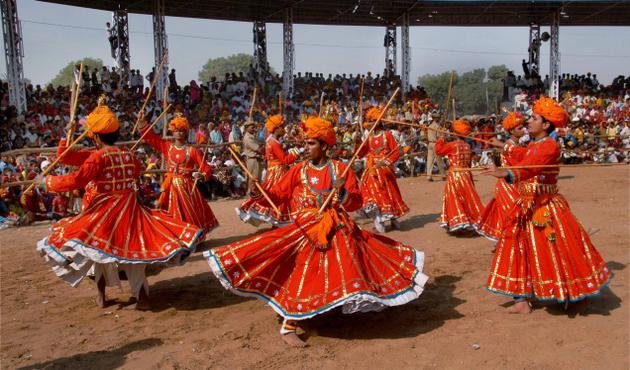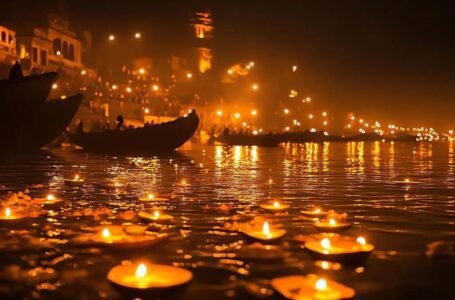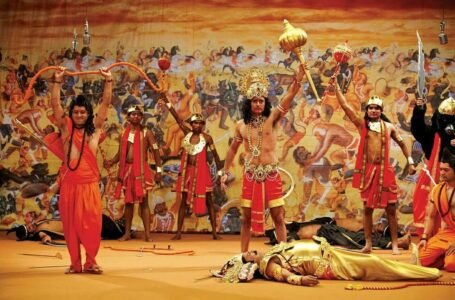Dandi Gair: A Cultural Jewel of Rajasthan

Dandi Gair is a stunning folk dance that showcases the cultural vibrancy of Rajasthan. A variation of the Gair dance, it is performed primarily in the Marwar region by the Bhil community. This dance, characterized by its intricate formations, rhythmic movements, and colorful costumes, embodies the martial history and festive spirit of Rajasthan. Its significance extends beyond entertainment, symbolizing unity, tradition, and the deep-rooted artistry of the region.
Roots in Circular Formations
The name “Gair” derives from the regional word meaning “circle,” reflecting the dance’s foundational choreography performed in circular formations. While Gair includes numerous regional variations, Dandi Gair stands out for its unique use of sticks, known as Khanda. These props not only enhance the visual appeal of the dance but also serve as a reminder of its martial origins.
Historically, Dandi Gair was performed by both men and women of the Bhil community, a prominent indigenous group in Rajasthan. Today, however, the dance is predominantly performed by men, with women’s contributions fading into obscurity. This evolution reflects broader societal changes but also highlights the need to revive and document women’s role in this art form.
Martial Legacy of the Bhil Community
The Bhil community, one of India’s oldest tribal groups, has played a significant role in Rajasthan’s history. During the Rajputana period, the Bhils were known for their skills as hunters and warriors, often serving as shikaris (hunters) and army personnel. This martial heritage profoundly influenced the creation of Dandi Gair.
The dance’s precise formations, synchronized movements, and use of sticks, swords, and shields reflect the military traditions of the Bhils. These elements celebrate the community’s strength and resilience, creating a powerful narrative of their historical contributions to Rajasthan’s defense and cultural fabric.
Spirited Movements and Technique
At the heart of Dandi Gair lies its dynamic choreography, which captivates audiences with its energy and rhythm. Performed in a large circle surrounding the musicians and singers, the dancers move in unison to the beats of traditional instruments such as the dholak, nagada, and dhol.
The dance alternates between clockwise and counterclockwise movements, creating visually stunning patterns. Performers strike their sticks together in rhythm, producing sharp, resonant beats that complement the background music. While the basic steps are simple, experienced troupes often incorporate complex patterns, intricate turns, and rapid transitions, showcasing their skill and artistry.
The choreography also involves movements that mimic combat techniques, a nod to the Bhil community’s martial past. These elements add a dramatic flair to the performance, making it a unique blend of dance and storytelling.
Vivid Costumes: A Feast for the Eyes
One of the most striking aspects of Dandi Gair is the performers’ vibrant costumes, which enhance the visual appeal of the dance. Male dancers typically wear long, flared kurtas in bright red or white, adorned with intricate gota patti embroidery in silver or gold. The kurta’s flared design creates a mesmerizing effect as the performers spin and twirl in circular formations.
These kurtas are paired with white churidar pants and turbans, usually in saffron or red, symbolizing valor and tradition. A sash matching the kurta is tied around the waist, completing the ensemble. Accessories like ghungroos (ankle bells) add to the auditory experience, while sticks, swords, and shields underscore the dance’s martial roots.
In recent years, some performers have adapted their costumes for modern convenience, wearing Western-style shirts beneath their kurtas and opting for comfortable footwear instead of the traditional barefoot approach.
The Rhythmic Pulse of Tradition
Music plays a central role in the Dandi Gair dance, setting the rhythm and mood for the performance. Folk songs, sung by accompanying musicians, provide a melodic backdrop, while percussion instruments create a pulsating beat.
The dholak, nagada, and dhol are the primary instruments used, producing deep, resonant sounds that resonate with the dancers’ movements. The rhythmic striking of sticks adds another layer of percussion, creating a harmonious interplay between music and motion. This synergy between sound and movement is a hallmark of Dandi Gair, captivating audiences and immersing them in the dance’s vibrant energy.
Festivals and Community Spirit
Dandi Gair holds a special place in Rajasthan’s cultural celebrations, particularly during festivals like Holi and Janmashtami. These occasions provide a platform for communities to come together and celebrate their shared heritage.
During such festivals, Dandi Gair is often performed in public spaces, drawing large crowds of spectators. The dance’s communal nature emphasizes unity and collective joy, reinforcing its cultural significance. The performers’ synchronized movements and the rhythmic beats of the music create an atmosphere of festivity and excitement, leaving a lasting impression on audiences.
A shift in Gender Dynamics
While Dandi Gair was traditionally performed by both men and women, the dance has undergone significant changes over time. Today, it is predominantly performed by male troupes, with women’s participation largely absent. This shift reflects broader societal changes but also raises questions about the preservation of the dance’s original dynamics.
Efforts to revive women’s role in Dandi Gair are crucial for preserving its cultural authenticity. Documenting the contributions of female performers and encouraging their participation in contemporary performances can help restore the dance’s inclusive nature.
Urban Popularity and Global Recognition
In recent years, Dandi Gair has gained immense popularity in urban areas, where it is frequently showcased at fairs, festivals, and cultural events. Its vibrant energy and visual appeal have also attracted international audiences, elevating its status as a symbol of Rajasthani heritage.
The dance’s global recognition has opened up new opportunities for performers, who now participate in cultural exchange programs and international festivals. These platforms provide a space for sharing Rajasthan’s rich cultural traditions with the world while fostering cross-cultural appreciation and understanding.
Preserving Tradition in a Modern World
Despite its popularity, Dandi Gair faces challenges in maintaining its traditional essence. Modern influences, including changes in costumes, music, and performance settings, risk diluting its cultural authenticity. Additionally, the reduced participation of women has altered the dance’s original dynamics, limiting its narrative scope.
To address these challenges, both governmental and non-governmental organizations are working to preserve and promote Dandi Gair. Initiatives include organizing workshops, documenting performances, and incorporating the dance into school curricula. These efforts aim to ensure that future generations can appreciate and carry forward this unique art form.
Variations Across Regions
Dandi Gair is closely related to other regional variations of the Gair dance, each with its unique characteristics. For instance, the Geendad dance, performed in the Shekhawati region, shares similarities in movements and formations but has its distinct style.
In the Mewar region, the Gair dance involves concentric circles, adding another layer of complexity to the performance. These regional variations highlight the diversity of Rajasthan’s cultural traditions, offering a rich tapestry of artistic expression.
The Spirit of Dandi Gair
Dandi Gair is more than just a dance; it is a living testament to Rajasthan’s rich cultural heritage and the enduring spirit of the Bhil community. Its vibrant movements, rhythmic beats, and colorful costumes captivate audiences while preserving the traditions of a bygone era.
As Rajasthan continues to embrace modernity, the preservation of Dandi Gair serves as a reminder of the importance of cultural heritage in shaping a community’s identity. By celebrating this unique art form, we honor the legacy of the Bhil people and ensure that their traditions continue to inspire future generations.
Conclusion: A Dance of Unity and Celebration
Dandi Gair stands as a symbol of unity, tradition, and artistic excellence. Its intricate choreography, vibrant costumes, and rhythmic music reflect the cultural richness of Rajasthan and the enduring legacy of the Bhil community.
By preserving and promoting Dandi Gair, we not only celebrate Rajasthan’s heritage but also create opportunities for cultural exchange and global appreciation. This dance, with its spirited energy and timeless appeal, will continue to captivate audiences and inspire future generations, ensuring that its legacy lives on for years to come.


